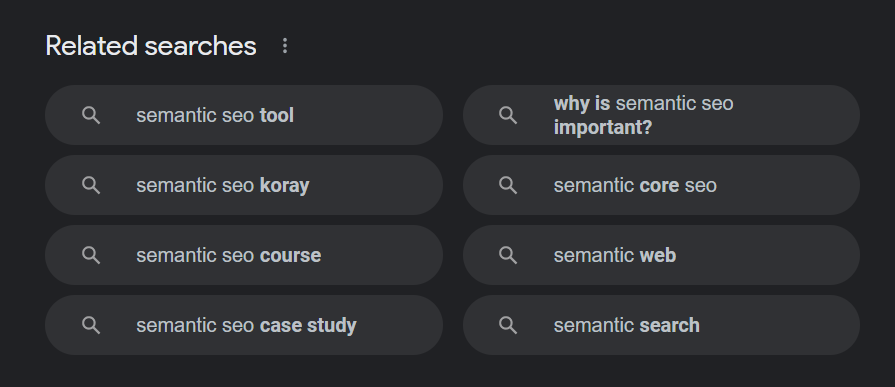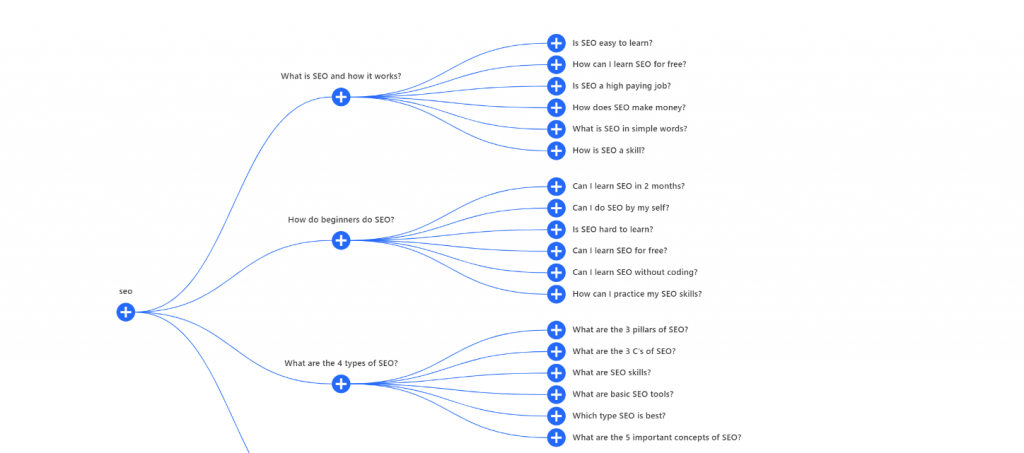The word “Semantic” literally means “relating to meaning in language or logic,” so we can say that semantic SEO is logical or meaningful SEO.
Previously, site owners would use a single keyword to rank higher. Thanks to google’s new algorithms, search engine optimization now relies more on the context and relevancy of your content.
Google now uses natural language processing (NLP) and deep learning to look for topical content and not one with relevant keywords or phrases. Semantic SEO is content focused and not keyword-focused.
What Is Semantic SEO?
Semantic SEO focuses on developing content based on a subject rather than a search term.
We know that Google uses algorithms to fetch millions of the best results for a query within microseconds. It is manually impossible.
However, Google is determined to provide its users the search experience nearest to what they will get if humans go through their queries.
Semantic search is Google’s attempt to work the logic and context behind words used on a page. A few years back, google may not fetch the pages with titles with the keyword “SEO” if a user searches with “search engine optimization.”
But google algorithms now go through a page for semantic signals and then present the best search results.
Google has taken these steps to make its search results more accurate and relevant.
Humming Bird
Google updates its algorithm and names it “Humming Bird”. It aids crawlers in better comprehending the meaning and logic behind queries, reducing the dependence on single keywords.
Knowledge Graph
It is an advanced and enormous database used by google that allows it to work out the association between specific entities and concepts.
Rank Brain
Rank Brain is a machine-learning algorithm that Google launched in 2015 to understand users’ intent better and thus present them with more relatable search results.
Now, it's hard for websites to fool Google crawlers by only using relevant and keyword-optimized headings with low-quality or less related content.
The race to get higher rankings was taking a toll on the user-friendliness of search engines. Therefore, google gradually updated its algorithms. Semantic SEO is the need of the hour for site owners.
Why Does Your Business Need Semantic SEO?
Semantic SEO helps you optimize your business website for the long term. Google monitors users’ activity on your pages to find how satisfied they are.
Your competitor might rank in the first position with the help of SEO gimmicks without focusing on providing value to its audience.
However, if you keep using semantic strategies for optimizing your pages, google might recognize you as a trusted resource.
For example, if a services page only contains babble and empty claims about the quality of your services without any evidence, users may bounce back early from it.
While another service page from the niche contains customer testimonials and clear and concise copy that talks directly about customers’ needs.
Users might stay longer on that page to identify why so many people trust this business. Algorithms will pick up this signal and give a higher ranking to this page than the previous page.
Related Read: How to Increase Leads Count through SEO (2023)
Semantic SEO Tactics to Elevate your Rankings
1- Use Keyword Clusters
Before google’s algorithm updates, SEO professionals used to create different pages for similar keywords like “ web design agency” and “website design agency.”
These are variations of the same keyword, but Google crawler used to treat them as different keywords.
You should not take the pain of creating multiple pages for keyword variations. Instead, create a single page that revolves around a keyword cluster.
Suppose your primary keyword is “ladies’ footwear.” Now your keyword cluster may include “ Best ladies' footwear,” ladies' footwear near me,” “ladies’ footwear under $10,” “ladies’ shoes,” etc.
These keywords have semantic relevance, meaning you can use all of them in a blog. It will help you rank for 10 to 20 keywords at comparatively higher positions, increasing your traffic.
2- Revamp Topical depth and Content’s Word Count
A study by SERP IQ shows that longer content is strongly correlated with higher rankings. The simplest way to apply semantic SEO is to create long-form content that covers all aspects of a topic.
This kind of content will show strong semantic signals to algorithms. Longer content allows you to avoid keyword stuffing.
Suppose your keyword is “best accounting software.” Now, you can create short content that only touches all the concepts involved and sprinkle primary and secondary keywords.
This content isn't useful for searchers looking for in-depth information on the topic. The semantic SEO tactic will be to write longer content that may inform:
- What is accounting software?
- What are its different types?
- What factors to consider when looking for the best accounting software?
- A list of some best accounting software
You should write nuanced, specific, comprehensive content to enhance its topical depth.
3- Add Synonyms & Related Terms

Another semantic SEO strategy is to toss multiple relevant keywords and synonyms with the primary keyword in your content. Google now performs semantic analysis and catches when you do so.
It doesn't directly impact your search result positions but google values such content for ranking. Today’s Google understands “smartwatch” and ‘smartwatches’’ are essentially the same keywords.
We recommend including related keywords in page titles, h1-h6, meta descriptions, and image alt text. It enhances the topical depth and makes content more readable for users.
4- Write the Topic Outlines
Don't write small pieces of content that don’t satisfy a searcher’s thirst for information or help them get the idea, just for the sake of keywords.
Google’s NLP model and other algorithms hunt for topic-based content that covers an umbrella of a specific concept and not just one sub-topic. Therefore, you should make topic outlines before you start writing.
Suppose you want to write on “search engine optimization.” Your topic outline may include these sub-topics:
- Definition of SEO
- Its benefits
- Its strategies
- Its examples
- SEO tools
- White hat and black hat SEO
- On-page and off-page SEO
- Link building
- SEO content
- Google algorithms
- And more
Google will notice that you have talked about nearly everything a searcher might want to know regarding SEO. And who knows, you will get the 1st position in SERPs and featured snippets.
5- Write Content on “People Also Ask” Questions

When you search on Google, a “People Also Ask” box appears on the search result page. Google tries to help searchers who don't know what keyword to type to get the best information on a subject.
You can improve your content’s semantic signals by answering those questions people are constantly typing in the search bar that Google has to add the query to this box.
For example, when we type “best jewelry brands in Dubai,” these queries appear in the most-asked questions box in google.
- Which is the best jewelry brand?
- Which jewelry brand is number 1?
- Which is the best gold brand in Dubai?
- Is jewelry cheaper in Dubai?
You can write a blog covering one of these queries or create in-depth content with a sub-section that answers that query.
A study of 2.5 million search queries revealed that the “people also ask” section appears for almost 48% of all and is often above the 1st position.
6- Create Content with Your Consumer in Mind
Semantics boils down to developing customer-focused content. Head to Quora or Reddit to know what your ideal customers are talking about and create content around the subjects most people seem to love.
For example, if you are a property developer, think about the topics that interest your target audience. These topics will be highly specific as they change with location and time.
People increasingly prefer voice search and using different keywords than text search. Google looks for content that encompasses a subject and provides conversational value.
7- Add Structured data (Schema)

It is not a semantic SEO technique but helps to inform google crawlers about a content’s meaning.
Structured data provides context on your web page and shows up on top of the content. We aren’t promising that structured data will make your rankings shoot to higher positions in search results.
It's worth mentioning that Backlinko conducted a study that shows no correlation between the usage of structured data and search results from positions.
Then what's the point of adding schemas to your pages?
They help crawlers comprehend your content, which can be useful sometimes.
Last but not the least, schemas may help you get Rich Snippets, increasing your website’s organic click-through rate.
8- Use Tools to Optimize Content
Want to create semantically optimized content but dread the mundane process of researching for semantically related terms?
Content optimizer tools have got you covered. They find these semantic terms in seconds that can enhance your content’s topical depth.
Add these subjects, queries, or phrases in your content to convey semantic signals to Google.
9- Develop Topic Clusters on your Site
While keyword clusters focus on a single page/content, topic clusters deal with more than one piece of content. Topic clusters are collections of blogs/articles revolving around a core topic.
Suppose your business wants to target “mobile app development” for its topic cluster. You can create a pillar page around it and write several content pieces, each focusing on a different keyword cluster.
The keyword clusters may target web app development, affordable mobile app development, iPhone app development, machine learning apps, etc.
Topic clusters have three benefits:
- Revamps semantic SEO signals
- Increases the number of times your keywords rank
- Increase your site’s authority in the “mobile app development” niche
You can create multiple topic clusters for multiple products/services.
10- Optimize for Conversational Keywords
More than 40% of US adults conduct at least one voice search each day, as revealed in a Google study.
Voice search is booming as it makes searching easy even when driving, cooking, or doing other work.
People often perform voice searches as if they are talking to Google, which is different from text searches.
It helps Google figure out the topic of a user’s query and not only keywords, which is what semantic search is all about.
Try to optimize your content for natural language keywords like “Best baby wipes in the USA, rather than ‘best baby wipes USA.”
Thankfully, now you can and should write in a language that seems more human. It helps your semantic SEO and increases your chances of showing up for voice searches, which is a thriving segment of searches.
Bottom Line
Semantic SEO is significant for search engine optimization. Readers now look for extensive content that incorporates all facets of a subject and answers all the most common queries.
Users feel wary of empty content with filler words written for SEO. As a marketer, you should apply these semantic SEO strategies on and off your website.
We mean your on-page and off-page content should be written from the point of view of the readers. Your customers may be happy if you only link to and get links from the most useful resources in your niche.
Maven Digital is a digital marketing agency that offers the best packages for SEO services to suit every business. Our proficient team optimizes your website for semantics, increasing your rankings quickly.
Contact us today to attract more quality traffic and earn conversions and sales!
FAQs
1- What is Semantic SEO?
Semantic SEO is a way of developing relatable and valuable content.
2- What is semantic markup in SEO?
Semantic markup is the HTML code of content markup of a specific page when considering: headers, lists, content headings, navigation, page sections, and paragraphs.
3- Why do businesses use semantic tags for their website’s SEO?
Search engines and users’ devices use semantic tags to understand the significance and context of pages.
4- Does Google use a semantic search?
Yes. Google uses semantic search to figure out the link between words to present the most relevant search results.








